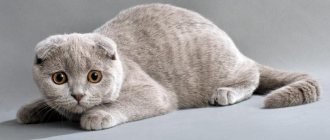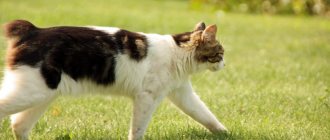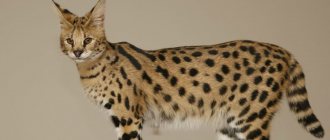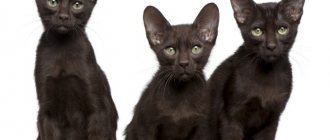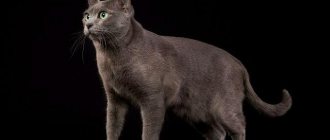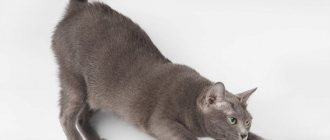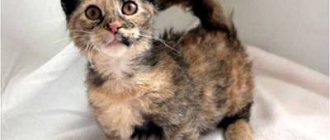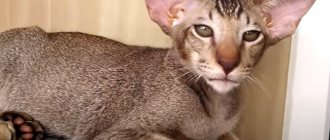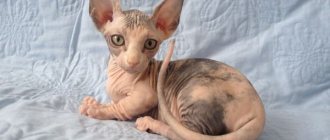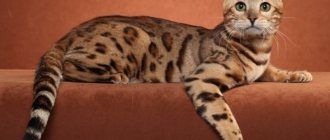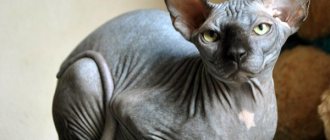Representatives of the British and Scottish breeds have identical external characteristics. They have incredibly beautiful fur, expressive eyes and the kindest character. People who buy a plush pet don’t see the difference, but there is one! In our article we will look in detail at the question of how a Scottish cat differs from a British cat.
By comparing the distinctive characteristics, every person who dreams of finding a new friend with plush fur will be able to choose the right purebred cat, focusing on the individual characteristics of each representative.
What kind of cat breed is Scottish Fold and Scottish Straight: definition, photo
The Scottish Straight cat is a straight-eared cat bred in Scotland in the 1960s from the British cat breed.
The Scottish Straight is medium in size and appears to be quite well-fed (especially boys), due to its round cheeks that extend into a short neck. The weight of a cat is up to 3.5 kg, a cat – up to 5 kg. The legs are short, the tail is of medium length, the ears are wide at the base, pointed at the tips, spread to the sides. The eyes are large and round; because of them, a kitten, and then an adult cat, has a childish expression on its face for the rest of its life. The nose is small. The coat is thin, moderately long, as if plush, of various colors (black, gray, chocolate, brindle).
The Scottish Straight cat is balanced and easygoing, gets along with everyone in the family, but at the same time she has a sense of self-esteem. She chooses one owner, is very smart, understands every word, is curious, resistant to stress, easily tolerates moving, gets along well with other animals.
Scottish cat breed Scottish Straight
The Scottish Fold or Scottish Fold cat is very similar to the Scottish Straight in all respects, but its ears are folded forward, some folded 2 or 3 times. Also, the Scottish Fold has a shorter tail. Among Scottish Fold cats there are different characters: slow, agile, slightly aggressive, affectionate, but this breed has one feature - to remember what is beneficial to it .
Scottish cat breed Scottish Fold
Note : Only chocolate-colored cats of the Scottish breed produce litters of different colors and shades.
A Scottish kitten quickly gets used to the toilet and scratching post; the only thing it can’t stand is being forced to do anything .
Scottish cats are in good health; no genetic diseases have been detected. You can feed them :
- Canned food at room temperature, but not all the time.
- Mixed diet (dry food as the main food, and complementary foods - fish, milk, milk porridge, chicken, beef liver and meat, boiled vegetables).
Important . Fur, like the plush of Scottish cats, is difficult to remove from the stomach of the animal, so as not to harm the cat, while still a kitten, at the age of six months, it is taught to eat a special paste that removes hair.
Care and maintenance
To properly care for a mestizo, you need to know from which parents he was born. If several varieties of purebred genes are mixed in the kitten’s blood, then the best adviser on keeping the animal will be the breeder, who will tell you what nuances you need to pay attention to.
The cat is drooling: the main causes and treatment options
If the animals do not require special care, then standard procedures are carried out:
- inspect for fleas;
- get rid of all parasites;
- get vaccinated;
- carry out sterilization.
Cats have their teeth and ears cleaned and their fur combed once every 10-14 days. Bath felines if necessary.
Additional information: Cats can suffer from a variety of infectious diseases. The most dangerous are: rabies, feline distemper, calcivirus, coronaviruses.
The appearance of vomiting, diarrhea, and ulcers on the body should be an immediate reason to contact a veterinary hospital.
Hybrid kittens of the Russian blue breed
Mestizo nutrition
Animals are not fed what humans eat. The dishes may contain products, the excess of which will be harmful to animals. It is rational to use special food for cats that contains the vitamins, minerals, and trace elements necessary for animals. Boiled meat, fish, vegetables, and low-fat milk are added to them. Cats should not be given sweets, smoked or salty foods.
Water is an integral part of food for animals. It must be clean, non-chlorinated. It is better to use drinking purified water. The dishes from which cats eat should always be thoroughly washed, and they should be boiled or disinfected at least once a week.
Recently, cat breeds have changed a lot, so the appearance of all kinds of crossbreeds has become commonplace. Some of them have body features and coat color that have become very exotic and unusual. Those who like to modify animals should always remember that animals are loved not so much for their appearance, but for their gentle purring and unobtrusive presence.
What is the British cat breed: definition, photo
British Shorthair cat breed
According to one version, the ancestors of the British cat breed were brought to the British Isles by the ancient Romans at the beginning of our era. Of course, they didn't look the same as they do now. Over time, the cats got used to the humid and cool climate of the islands and acclimatized. The main purpose of ancient cats was to catch rodents.
The first cat show in Great Britain took place in 1871, and the cats were recognized as purebred and began to be called British.
The British Shorthair cat is larger than average in size, girls weigh up to 4 kg, boys - up to 6 kg. They are squat, with a wide chest, well-developed muscles, short thick legs and a thick tail, a massive head, thick cheeks, a small nose, and medium-sized ears. The Briton's coat is thick and short, of different colors and shades, but the classic ones are lilac and blue.
Breed Features:
- Pronounced fold of skin around the neck
- On the nose, closer to the forehead, there is a small depression
- The chin is aligned with the nose and upper lip
- Kittens have bluish-blue eyes, gradually changing to bright orange - in adults, green and blue eyes are occasionally found in this breed
- Very thick short coat, plush in appearance
British cats of these colors can take part in competitions:
- Plain
- Painting with a pattern
- Tortoiseshell (tri-colored, when one color smoothly transitions into another)
- Smoky
- Combination of two colors
- Chinchilla (faint various colors)
- Siamese color type (on the face, tail and paws the fur is darker than the rest)
The British cat is characterized by good health.
Differences between British and Scottish Fold according to international standards
| British Shorthair | Scottish Fold | |
| Ears | Rounded at the tips, wide at the base. Definitely short. | The ears are small, but droop down and forward. Together with the head they should form a triangle. |
| Torso | We can say that the chest is wide, like that of a good fighting dog. | More rounded, also athletic, but more even from the shoulders to the tail. |
| Paws | Powerful legs on a small body, they are not long, so the animal looks massive. | The average length of the paws, which are proportional to the body. More slender than the British. |
| Head | The cheeks stand out against the background of the round head. | Something like an owl. The lower part with the chin is well developed. |
| Nose | No bending when transitioning from the forehead. It should have a depression at the forehead. | Voluminous and short nose with widening towards the base. |
| Tail | Relatively short and thick, rounded towards the end. | Medium length and thickness, very mobile, pointed towards the tip. |
| Eyes | Round like buttons. They are far away from each other | Forever surprised and greatly opened up. |
| Wool | Plush, but feels firmer. | The soft one also has a good undercoat and a “plush” characteristic; it can be long and not close-lying. |
World-recognized breeds immediately acquire standards, according to which judging takes place at exhibitions. The selection of a kitten should also be based on these criteria. Compliance with them indicates the purebredness of a representative of a particular species.
Below are the CFA standards for the two species considered.
| British | Scottish fold | |
| Body | The body of an athlete in a cat role. The tail is long and not very mobile. Its tip should be rounded. Short legs. | Round and medium, strong. The legs are not short, which resemble the legs of a slender model. The tail is medium or long. Tail flexibility is high. The end must be pointed. |
| Head | A strong chin stands out on a round head. Small nose. Well defined cheeks. | Well rounded with a strong lower part. Set low on the neck. Well defined cheeks, more so in boys. Let's say a small stop on the nose. |
| Ears | Medium height, wide towards the bottom. They should also be rounded at the tips. | Small and bent. The tips look not only down, but also forward immediately. |
| Eyes | Large, very open, different colors. | Constantly surprised facial expression. Cats with different eyes are allowed, but only white or bicolor. |
| Wool | Short with well-developed undercoat. The texture is not woolly, but fleecy. | Dense, plush, length from short to slightly elongated. Soft. The texture depends on the season, place of residence and color. |
| Color | Any color and with points (spots, stripes), except for white splashes. | Any natural colors (blue, white, black, striped) |
These standards also talk about defects that could disqualify a cat. This means that their professional breeding will become impossible. For the British, this is the presence of a stop at the transition from the forehead to the nose. For Scottish Folds, prominent brow ridges, a short and rigid tail with a hook, splayed toes, lilac, chocolate or a combination of both and white.
Both of these breeds are great friends and adapt to any environment. They are friendly and easy to care for. When choosing a kitten, decide whether you want a more massive and larger cat (British) or a plush friend with higher legs and a less muscular body (Scottish Fold).
Video on the topic
Cats are one of the most popular pets. The entire Internet is replete with photographs of cute faces. Some people prefer purebred cats, others pick up furry friends on the street and do not attach importance to their origin. Those who want to buy a purebred cat or male cat simply need to become thoroughly familiar with the different breeds of these animals. Some people are confused by the similarities between the two breeds - British and Scottish. What is the difference? How are they different from the British ones? Sometimes on specialized websites and in newspapers you can find an advertisement for the sale of a British Fold kitten. Is this possible?
How do British cats differ from Scottish cats in coding: comparison
For purebred animals, a metric is created, where the pedigree is indicated.
For a purebred animal, a metric is created, where its pedigree is indicated. In order not to describe too much about the animal, all records in the metrics are entered under generally accepted coding.
The most common phenological organizations: WCF, CFA, FIFE, IFA, TICA.
The pedigree indicates:
- Number assigned by a club or association
- Animal name
- Breed (indicated in coded form)
- Parents
- Grandfathers, grandmothers, great-grandparents
- Information about other kittens from the litter
- Last name and first name of the breeder, phone number
In the phenological association WCF are designated:
- British Shorthair – BRI
- Scottish Fold Shorthair cat – SFS
- Scottish Fold Longhair cat – SFL
- Scottish Fold cat without fur length designation - SFT
- Scottish Straight Shorthair cat – SCS
- Scottish cat Scottish Straight longhair – SCL
How do British cats differ from Scottish cats in character and habits: comparison
A kitten of the British Shorthair breed
The British Shorthair cat is a kind of aristocrat, she will not play with children, will not tolerate being carried in her arms, at most - stroke her fur. She is not aggressive, but prefers to be alone more time.
But the Scottish Fold and Scottish Straight cats will allow you to play with them all day long without being aggressive.
One and the other type of cat has some unusual features :
- Scottish cats can sometimes be seen standing on their hind legs, or sitting like humans - on their butts, they require such postures to straighten their spine. British cats do not have this.
- Scottish cats are afraid of heights, while British cats, on the contrary, try to climb higher.
Thai cats and their differences from mixed breeds
At the turn of the 19th and 20th centuries, Siamese cats appeared in England, but people noticed that they differed from each other in body structure and divided the breed into two types:
- cats with a strong build and rounded heads are the ancestors of today's Thais; graceful with an elongated muzzle - Siamese.
The Thais interested scientists and work began to improve the breed. As a result of the work, today there are three types of Thais: classical, traditional and modern.
Purebred Thai cats should have a large round head with a high forehead and a convex, powerful sternum. Almond-shaped eyes and set ears prove that the breed came from the East. Thanks to numerous crossings, the standard color of the Thais was diluted with cream, red, tortoiseshell and tabby (brindle).
By nature, these are loyal, balanced cats with high intellectual abilities, very sociable and able to change intonation.
A mixed-breed Thai cat, after crossing with a barn cat, has a pronounced external resemblance to the breed, but is fundamentally different in character due to its unbalanced psyche. Such mestizos can be aggressive and angry. This is due to the instinct of a hunter who is forced to defend his territory in the street.
If a mestizo comes from different breeds, then the traits of both parents will be visible in the character and appearance.
Which of the cats, cats, kittens is more expensive, smarter, larger, more affectionate, kinder: British or Scottish?
Kittens of the British and Scottish breeds
The British cat is affectionate, friendly, smart, gets along with all family members, and even other animals, is endowed with great patience, but will only do what it considers necessary. If your family is noisy and has children, a British cat is not suitable; she likes to spend more time alone.
Scottish cats (straight-eared and fold-eared) are calm, flexible, resistant to stress, do not meow unnecessarily, but only when asked to eat, are easily accustomed to order, and will play with children.
The price of British and Scottish cats depends on many factors:
- Purebred breed
- Correct execution of all documents for the cat
- The merits of the kitten's ancestors
Of course, British cats, due to the antiquity of the breed, will be more expensive.
How to distinguish a British kitten from a Scottish one: comparison of kittens by breed
It is very difficult to distinguish small kittens by breed; this is possible only after 3 months of age
distinguish a British from a Scottish kitten by the following signs:
- The British breed kitten is shorter, with massive paws and stockier than the Scottish one.
- British cats have erect ears with a rounded tip.
- The Scottish kitten has a longer tail and neck, a more clearly defined chin, and an oval muzzle that resembles the head of an owl; The British have a short tail, a rounded tip, large cheeks, because of them the neck is not visible.
- You need to buy a kitten at the age of more than 3 months, because with small kittens you cannot determine who is in front of you - British or Scottish, they all have erect ears, and after 1 month of age, Scottish Fold ears begin to droop.
- The British cat breed is characterized by late maturation (cats under 3 years old, cats over 1 year old or finally after the second birth), in contrast to the Scottish breed.
Is it possible to breed a British cat with a Scottish cat?
Video: Why are Scots and Brits different breeds? What is the difference? Why can't they crossbreed?
The Scottish cat breed is young. At the very beginning of the breeding, it was crossed with the British cat, but studies have shown that this is harmful to both types of cat breeds.
Now, according to new requirements, in order to preserve the pedigree of British kittens , a cat and a male cat of the same color are selected for mating.
It is also impossible to breed fold-eared cats and female cats together - this leads to kittens being born with bone abnormalities (curvature of the spine, crooked legs, thickened tail). Now Scottish Folds and Scottish Straights are being bred together, and the offspring are half like the dad and half like the mom.
Differences in Personality
Scottish cats have a gentle character. They are more willing to compromise than the British. The Scots are affectionate and sociable, they follow the one they have chosen as the owner, and enjoy contact with family members. They often find a common language with children, but this does not apply to all representatives of the breed. Scottish cats love active games, travel and exhibitions. They will not refuse to walk outside if the owner takes care of safety and puts a harness on the pet.
Scottish cats may stand on their hind legs when they are curious or want to attract their owner's attention.
The British are called aristocrats. They are calm and sedate, sedentary and majestic. They are more inclined to observe what is happening than to participate in anything. The British are not very demanding: if they are hungry, they will not ask loudly, but will wait silently. They are unobtrusive and are well suited for those people who do not like their pets to attract attention.
Scottish cats have amazing artistry, flexibility and charisma: they even like to sit like a human, not like a cat.
My sister has a British cat, and I have a Scottish cat at home. My favorite is not as affectionate as in the descriptions of the breed: she can bite if she doesn’t like something, and she doesn’t like to sit in your arms. Before castration, the cat often hid from me or sat in her house. But now she often comes up and asks to pet her and doesn’t mind if I do it spontaneously, but my sister’s cat doesn’t like unnecessary attention to herself. When guests arrive, he climbs up and sits there. Mine loves meeting new people, although she spends a long time sniffing around. Both my cat and my sister’s cat don’t like children: they hide behind the furniture. Mine, however, will hiss at first and may bite. The Briton is more patient, but he clearly doesn’t like intrusiveness. From my experience, I will say that Scots are better suited for those who want a cat as a companion. The British make contact and play with pleasure, but it is difficult to expect signs of attention and devotion from them.
Which of the cats, cats, kittens is better to buy or get: a British or a Scotsman?
British breed cat
If you are going to buy a Scottish or British kitten, you need to follow some tips:
- Before buying a little fluffy, check the metrics, medical record, and make sure that the necessary vaccinations have been completed.
- If you have a family without children and are rarely at home, you need a British man, he loves to be alone.
- Scottish cats love communication more, constantly hang around their owners, play well with children in outdoor games, but do not tolerate being squeezed or tormented.
So, now we know how to distinguish a British cat from a Scottish one.
Emeralds - for gold and silver
What are the eyes of British cats that have “noble metals” in their colors? If we are talking about gold, that is, the colors “golden tabby”, “golden shaded” or “golden chinchilla”, then only a British cat with green eyes corresponds to it. There are no other options - gold in this case should only be combined with greenery in bright shades.
As for silver cats - the same tabbies, chinchillas or “silver tabbies” - their eyes can be either green, preferably a shade of turquoise, or yellow-orange.
